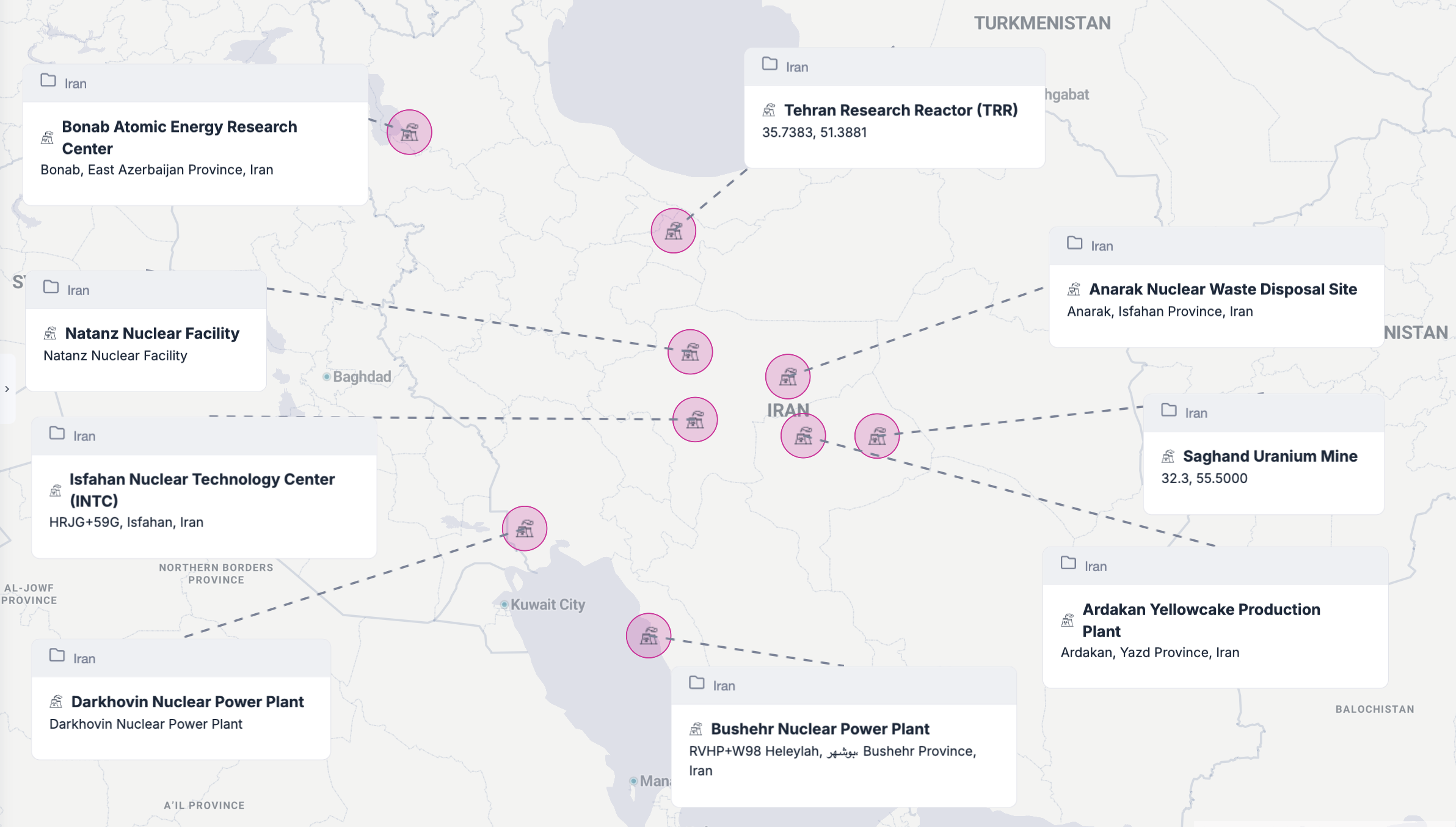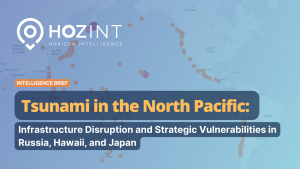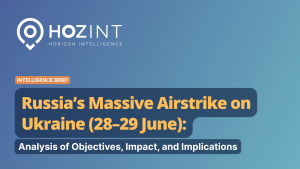Key Points
- Israel may be preparing imminent airstrikes on Iranian nuclear facilities, exploiting a perceived window of opportunity while Iran is weakened militarily and diplomatically.
- US intelligence has tracked Israeli military activity, including air munitions movements and completed exercises, indicating readiness for a strike, though some indicators may be strategic signalling.
- Potential targets include Natanz, Fordow, Isfahan, Bushehr, and Arak; previous attacks on similar facilities reveal Israel’s operational methods and limitations.
- A strike could disrupt regional aviation, especially over Iraq, the Persian Gulf, and Israel, with potential airspace closures, reroutes, and cyber risks.
- Recent US-Iran diplomatic efforts have yielded little progress since the US withdrew from the JCPOA in 2018, further diminishing chances for a peaceful resolution.
Event Description: Who, What, When, Where, and How
Who: The Israeli government and military; the Iranian government and nuclear program; US intelligence and military observers.
What: A potential Israeli airstrike on Iran’s nuclear infrastructure, possibly imminent, based on intelligence intercepts, Israeli military activity, and strategic calculations.
When: Unknown.
Where: Possible Israeli strikes would target Iranian nuclear sites at:
-
- Natanz (Isfahan Province): Fuel enrichment facilities were previously sabotaged in 2020 and 2021.
- Fordow (near Qom): Deep underground enrichment site.
- Isfahan Nuclear Technology Centre: Conversion and fuel fabrication.
- Bushehr: Civilian nuclear power reactor.
- Arak (IR-40): Heavy water facility under past scrutiny.
How: Military aircraft and long-range missiles are likely strike methods. US assessments indicate Israel lacks the capability to fully neutralise Iran’s nuclear program without US logistical support (notably midair refuelling and bunker-busting munitions).
Analysis
Israel’s apparent preparations for a strike on Iran’s nuclear infrastructure reflect both immediate strategic calculations and historical patterns of Israeli military doctrine. With Iran’s air defence systems and missile capabilities significantly degraded—largely due to recent Israeli operations—combined with the ongoing economic strain from international sanctions and the weakened operational reach of Iranian proxies such as Hezbollah and the Houthis, Israel perceives a fleeting moment of strategic advantage. The Israeli leadership likely sees this period as an opportunity to either delay Iran’s nuclear advancement or reinforce its deterrence posture by demonstrating its willingness to act decisively.
Despite these preparations, there is a degree of ambiguity in Israeli intentions. Observed military maneuvers, including the repositioning of air munitions and completion of significant air exercises, may serve dual purposes: not only could they support actual strike planning, but they also act as signaling tools to pressure Iran into curbing its nuclear ambitions. This ambiguity creates a difficult policy environment for the United States, which must balance its alliance with Israel against broader regional stability.

Iran’s nuclear facilities
From a historical perspective, Israel’s record of acting unilaterally to neutralise perceived existential threats is well-established. The 1981 bombing of Iraq’s Osiraq reactor and the 2007 strike on Syria’s Al-Kibar facility illustrate Israel’s willingness to act preemptively. More recent covert operations, including cyberattacks and sabotage at Iran’s Natanz facility in 2020 and 2021, reveal a continuation of this doctrine, albeit with limited long-term success. These past efforts succeeded in delaying adversarial programs, but often at the cost of driving them further underground and hardening their defences. A similar dynamic is likely to play out if Israel launches new strikes on Iranian nuclear sites.
| Facility Name | Location | Type |
|---|---|---|
| Natanz Nuclear Facility | Natanz, Isfahan Province | Uranium enrichment (Fuel Enrichment Plant and Pilot Fuel Enrichment Plant) |
| Fordow Fuel Enrichment Plant (FFEP) | Near Qom | Underground uranium enrichment facility |
| Isfahan Nuclear Technology Center (INTC) | Isfahan | Uranium conversion, fuel fabrication, research reactors |
| Bushehr Nuclear Power Plant | Bushehr | Nuclear power generation (VVER-1000 reactor) |
| Arak Heavy Water Reactor (IR-40) | Arak (Khondab) | Heavy water reactor (under redesign to limit plutonium production) |
| Tehran Research Reactor (TRR) | Tehran | Research reactor for medical isotope production |
| Parchin Military Complex | Southeast of Tehran | Alleged nuclear weaponization research and explosive testing |
| Saghand Uranium Mine | Near Yazd | Uranium mining |
| Ardakan Yellowcake Production Plant | Ardakan, Yazd Province | Uranium ore processing to yellowcake |
| Anarak Nuclear Waste Disposal Site | Near Yazd | Nuclear waste storage |
| Lashkar Abad Facility | Near Karaj | Laser isotope separation research (reportedly inactive) |
| Bonab Atomic Energy Research Center | Bonab, East Azerbaijan Province | Nuclear research, including agricultural applications |
| Darkhovin Nuclear Power Plant | Darkhovin, Khuzestan Province | Planned nuclear power plant (construction started in 2022) |
Implications for Civil Aviation
The potential implications for civil aviation are considerable. Drawing on patterns from earlier conflicts and recent reporting, a military confrontation between Israel and Iran could result in widespread airspace closures over Iran, Iraq, and potentially parts of the Persian Gulf. This would force international airlines to reroute flights, particularly those operating between Europe and Asia. Moreover, Iranian-linked cyber groups have shown a proclivity for targeting public infrastructure in retaliation, and a military escalation could invite cyberattacks on Israeli or Western aviation assets, potentially disrupting airport operations or targeting aviation databases and logistics networks. The downing of Ukrainian International Airlines Flight 752 by Iranian air defences in 2020 serves as a grim reminder of how quickly civil aviation can become collateral damage in regional escalations.
Diplomatic Outlook: US-Iran Engagement
The spectre of an Israeli military strike on Iran’s nuclear infrastructure emerges at a time of heightened but fragile diplomatic engagement between Washington and Tehran. Despite Israeli signalling and apparent preparations, multiple U.S. officials have emphasised that Israel has not yet made a final decision. The timing of these developments is critical, as the Trump administration has re-engaged in diplomacy with Iran through indirect talks mediated by Oman, aiming to secure a new nuclear agreement.
Four rounds of negotiations have taken place since April 12, with meetings in Muscat and Rome. These discussions, led by U.S. Special Presidential Envoy Steve Witkoff and Iranian Foreign Minister Abbas Araghchi, reflect a renewed, though increasingly tense, effort to prevent nuclear escalation. However, the talks have stalled over a central demand by the U.S. that Iran cease all uranium enrichment—a process with dual-use potential for both civilian energy and nuclear weapons development. Iran, for its part, maintains that it will not surrender its right to enrich under the Non-Proliferation Treaty (NPT) and has publicly rejected the American position as a strategic miscalculation.
President Trump has personally set a tight window for the success of diplomacy. According to sources familiar with a mid-March letter he sent to Iran’s Supreme Leader Ayatollah Ali Khamenei, Trump gave negotiations a 60-day deadline to produce results. That deadline has now passed, and while additional talks are tentatively scheduled in Rome for May 24–25, no final proposal from Washington has yet received the President’s formal endorsement. Witkoff recently stated that the U.S. cannot accept “even 1% of enrichment capability” in any deal, a stance that appears to clash fundamentally with Iran’s negotiating red lines.
This unresolved impasse has left Israel in a precarious strategic position. Prime Minister Benjamin Netanyahu is caught between opposing imperatives: he must resist a nuclear deal that Israel perceives as inadequate, while avoiding a unilateral action that could alienate President Trump, who has already disagreed with Netanyahu on other regional security matters. While Israeli officials recognise that striking Iran without U.S. coordination could rupture the bilateral relationship, they are also signalling readiness to act alone if Washington proceeds with what they consider a “bad deal.”
The Israeli calculus, therefore, is heavily shaped by the trajectory of U.S. diplomacy. If talks break down entirely or result in a compromise that allows Iran to retain enrichment capability, Israeli leaders may feel compelled to act militarily, particularly given longstanding Israeli intelligence assessments that only force can halt Iran’s nuclear trajectory. U.S. officials themselves acknowledge this concern. One told CNN that the risk of an Israeli strike has “gone up significantly in recent months,” driven by fears that diplomacy may fail to achieve full denuclearisation.
Despite these warnings, Trump administration officials remain divided over whether Israel will ultimately act. Some believe the current Israeli military activity is a pressure tactic to influence the outcome of U.S.-Iran talks. Others argue that Israeli doctrine, which has historically prioritised preemptive strikes to neutralise existential threats, as in Iraq in 1981 and Syria in 2007, suggests that military action is more than just rhetoric.
For now, the White House continues to prioritise diplomacy, though that window is clearly narrowing. Whether or not Israel strikes will likely hinge on how the coming rounds of U.S.-Iran negotiations unfold—and crucially, on whether President Trump ultimately signs off on a deal that Israel can tolerate. If not, Israeli action could follow, setting off a chain reaction across the region at a moment of acute instability.
Forecast
If Israel proceeds, the following scenarios are likely:
- Short-term escalation: Iran retaliates using proxies in Lebanon, Iraq, Syria, or Yemen, possibly including missile strikes on Israeli cities or US bases in the Gulf.
- Limited rollback of Iran’s nuclear program: Damage to sites like Natanz or Fordow may delay, but not destroy, nuclear capabilities. Enrichment can resume within months unless deeper infrastructure is neutralised.
- Increased risk to aviation: Airspace disruption across the Gulf and cyber retaliation against aviation systems.
- Dampened diplomacy: US-Iran talks will stall further; Iranian hardliners will likely gain political leverage internally.
A more severe regional conflict could emerge if Hezbollah enters the fray or if US forces are targeted, prompting Washington to intervene. Alternatively, if Iran exercises restraint, conflict may remain localised.
Conclusion
While the intelligence suggests a high likelihood of an Israeli strike, the strategic objective—permanently halting Iran’s nuclear ambitions—remains elusive without US military backing. The regional security environment, aviation safety, and diplomatic prospects all hinge on the scale and outcome of Israel’s next move. The consequences may echo past operations, but the volatile context in 2025—including the war in Gaza and tensions with Hezbollah—could rapidly amplify the conflict.




